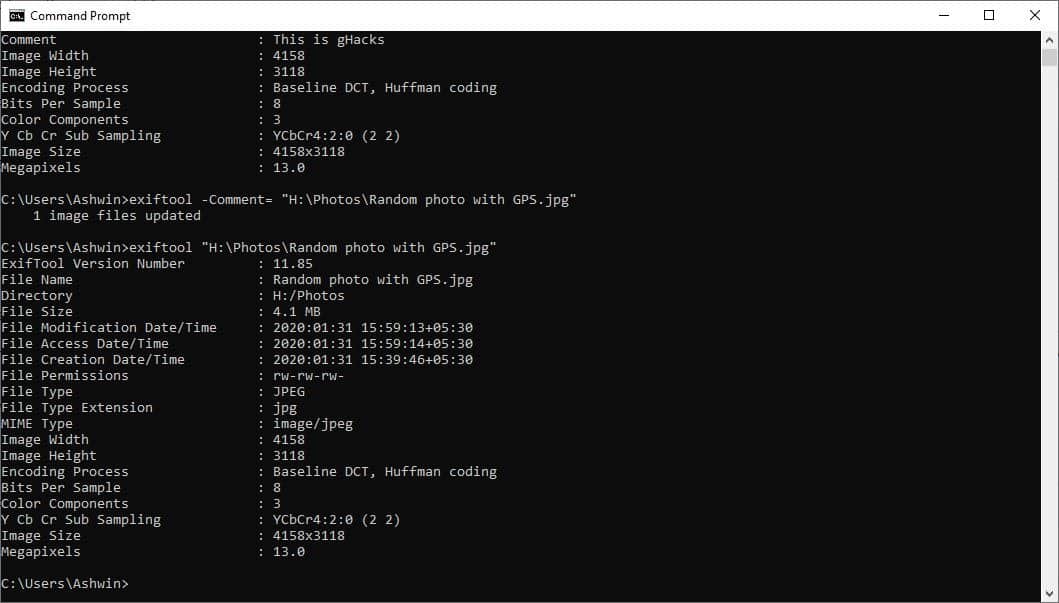
Best used when have different titles, descriptions, etc.
#EXIFTOOL VIDEO TAG PDF#
Note: Can only use for images and PDF format types. Use -tagsFromFile SRCFILE exiftool -TagsFromFile src.crw dst.jpgĬopy the values of all writable tags from "src.crw" to "dst.jpg", writing the information to the preferred groups.Įxclude a tag from being copied ("-TAG"), Excluding a tag will prevent it from being copied to the destination image

Will need to add separatelyĬ:\Users\mpr1>exiftool -csv -r F:\ >c:\Users\mpr1\Desktop\output.csv Tip: output data does not contain headers for columns. Option 2: This example contains switches specific to local practices.Įxiftool -T -FileName -ImageDescription -Source -Rights -ICCProfileName -MIMEType -ImageSize -XResolution -Compression -BitsPerSample -Make -Model *.tif >exifdata-output.txt

(c) When finished, on screen will display # of directories reviewed and # of files readįigure: Example output using -csv tag (extensive data) (b) run command : exiftool -csv -r group >output.csv (where "group" is the name of the top level folder containing subfolders) (a) Open command window at parent directory May be used to help identify what tags exist with batch of newly received files as this option will list everything. Option 1: Provides ALL tags for files within subfolders. Image file types: Output multiple characteristics for a batch of files To extract page counts for multiple PDFs:Įxiftool –Filename –T –PageCount *.pdf >output-pagecount.txt )Ĭopy/past command from below examples or enter your ownĭisplay common characteristics for single fileĭisplay common characteristics for multiple files (which removes the need to manually type out the commands in a command prompt window. This will output the results to a txt file. Then make a selection of what information you may wish to extract.īatch process: Copy any of the below example commands (shown in red) to a. Since exifdata can vary greatly depending on file type and camera source, recommend testing a file or small representative sampling of files using the –H command to see all information available.

Display common characteristics for single file.Here is something that I find useful: Create a copy of ExifTool and name it exiftool(-a -G1 -s -k).exe.You will probably want to turn off the Instant Preview or only select a single file while typing ExifTool tags. See the ExifTool documentation for more info on what is supported. You can type a group name first to be more specific. This will return the value of "TagName" (provided such a tag exists in the file of course) Finally move the file in the folder where Flash Renamer is installed, for example c:\Program Files\Flash Renamer\.ĮxifTool implemented as a and can be used anywhere tags are allowed.Change the name of this file to just exiftool.exe.
#EXIFTOOL VIDEO TAG ZIP FILE#
When finished, open the zip file and extract the file exiftool(-k).exe.
#EXIFTOOL VIDEO TAG DOWNLOAD#
Go to ExifTool homepage and download the Windows Executable.This is a page from the Flash Renamer user manual.ĮxifTool by Phil Harvey is an advanced metadata utility that can read an enormous number of file formats, media properties and tag formats (see lists below).įlash Renamer already contains support for many metadata formats, but if you miss something there is a good chance that ExifTool supports it, and you can use ExifTool together with Flash Renamer to get this data into Flash Renamer!īefore you can use ExifTool you need to "install" it:


 0 kommentar(er)
0 kommentar(er)
